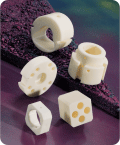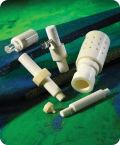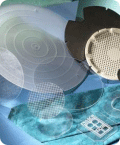Welcome to China Hard Materials Parts. Thank you for visiting!
Since 1947, we have been a precision machining and polishing fabricator of parts from all technical ceramics, sapphire, glass and quartz. We machine these materials to very precise tolerances (many times measured in millionths of an inch) for dimension, flatness, wedge and roundness or cylindricity. Our customers typically have a critical application that requires extremely tight tolerances in ultra-hard materials. We also have the capability to grind and polish spherical radius parts in a variety of hard materials, both inside and outside diameters, to optical requirements.
Please feel free to navigate to other pages within our site to see more information on all of our high precision machining services, materials and capabilities. If you would like more information please click here to send a request, or visit our Frequently Asked Questions page.
Sialon is a reacted mixture of SiN, SiO2, Al2O3 and AlN
Sialon is really a generic term for the technical ceramic comprised of silicon, aluminum, oxygen and nitrogen blended in ratios designed to emphasize certain properties. So as a category of material, individual producers/sellers of Sialon are free to offer specific composition which may vary from that offered by another. Since China Hard Materials Parts does not produce materials, we are free to source materials in the fired or hard state from the most suitable commercial producer.
We have years of experience working with producers of all technical ceramics and understand capabilities of most producers for their available sizes, and shapes as well as compositions. Sialons generally are produced by mixing silicon nitride, alumina, aluminum nitride, and silica along with small amount of some mixing aid like yttrium oxide. This powder mix is then pressed and pre-fired, and then as necessary, green machined to achieve desired basic form before final firing.
The silicon nitride component contributes hardness, strength, fracture toughness, and thermal shock resistance. While the alumina contributes properties of corrosion and oxidation resistance and electrical insulation.
Sialons have been formulated to emphasize hardness and toughness and also lower density. This is advantageous for body armor applications where weight is important to the soldier. These applications usually utilize material in the as-fired state perhaps only having been green machined prior. Body armor generally does not require overly tight dimensional tolerances so algorithms predicting dimension after firing induced shrinkage are adequate.
Another common application for Sialons is in low pressure die casting of non-ferrous metals. Here the high strength at temperature, good thermal shock resistance and exceptional resistance to wetting by metals offers great advantage over other refractory materials.
Where toughness, corrosion and wear resistance at high temperature as well as thermal shock resistance are vital in application, Sialons might be the best choice over other technical ceramics. This might be for severe duty pumps and valves, or dies for wire drawing or rolls for tube production. In these cases, designs often call for high precision of complex features. As with most technical ceramics specified for high tolerance parts, this is only possible by machining after final firing when parts are already extremely hard. Machining is performed by a diamond grinding process. As a specialty machine shop for over seventy years machining all technical ceramics, China Hard Materials Parts has developed techniques and expertise and equipment to achieve extremely tight control of dimensions on many complex shapes by diamond grinding, lapping and polishing.
*Click on a Property to see a comparison of up to 10 materials



